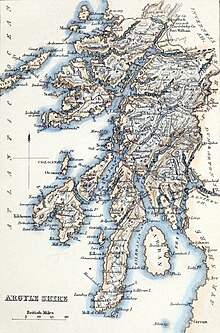
Back Arregaðel ANG Arqayl Azerbaijani Аргайл Byelorussian Earra-Ghàidheal Breton Argyllshire CEB Argyll German Argyll Spanish Argyll Basque آرگیل Persian Argyll (Écosse) French
| Argyll Earra-Ghàidheal (Scottish Gaelic) | |
|---|---|
| Historic county | |
 | |
| Area | |
| • Coordinates | 56°15′N 5°15′W / 56.250°N 5.250°W |
| History | |
| • Preceded by | Dál Riata; Lordship of the Isles |
| • Abolished | 1975 |
| • Succeeded by | Strathclyde (Region, 1975-1996); Argyll and Bute (District, 1975–1996, Council area 1996–) |
| Chapman code | ARL |

Argyll (/ɑːrˈɡaɪl/; archaically Argyle; Scottish Gaelic: Earra-Ghàidheal, pronounced [ˈaːrˠəɣɛːəl̪ˠ]), sometimes called Argyllshire, is a historic county and registration county of western Scotland. The county ceased to be used for local government purposes in 1975 and most of the area now forms part of the larger Argyll and Bute council area.
Argyll is of ancient origin, and broadly corresponds to the ancient kingdom of Dál Riata less the parts which were in Ireland. Argyll was also a medieval bishopric with its cathedral at Lismore. In medieval times the area was divided into a number of provincial lordships. One of these, covering only the central part of the later county, was called Argyll. It was initially an earldom, elevated to become a dukedom in 1701 with the creation of the Duke of Argyll. Other lordships in the area included Cowal, Kintyre, Knapdale, and Lorn. From at least the 14th century there was a Sheriff of Argyll, whose jurisdiction was gradually extended; from 1633 the shire covered all these five provinces. Shires gradually eclipsed the old provinces in administrative importance, and also became known as counties. Between 1890 and 1975, Argyll had a county council. The county town was historically Inveraray, but from its creation in 1890 the county council was based at Lochgilphead.
The county is sparsely populated, with many islands and sea lochs along its coast, and the inland parts are mountainous. Six towns in the county held burgh status: Campbeltown, Dunoon, Inveraray, Lochgilphead, Oban, and Tobermory. Argyll borders Inverness-shire to the north, Perthshire and Dunbartonshire to the east, and (separated by the Firth of Clyde) neighbours Renfrewshire and Ayrshire to the south-east, and the County of Bute to the south.
Argyll ceased to be used for local government purposes in 1975. Most of the pre-1975 county was then included in the Argyll and Bute district of the Strathclyde region. The district created in 1975 excluded the Morvern and Ardnamurchan areas from the pre-1975 county, which were transferred to the Highland region, but included the Isle of Bute, which had not been in Argyll. Further reforms in 1996 abolished the Strathclyde region and made Argyll and Bute a single-tier council area instead. As part of those reforms, Argyll and Bute also gained an area around Helensburgh which had historically been in Dunbartonshire.